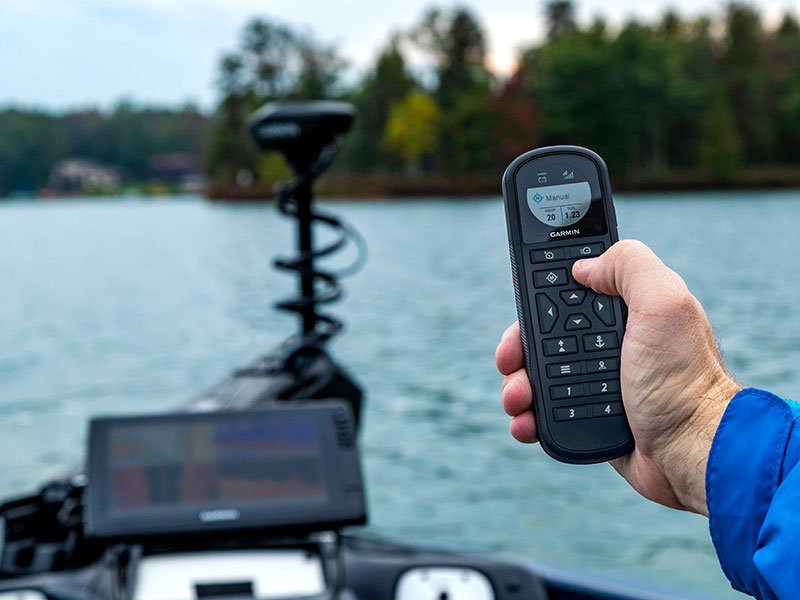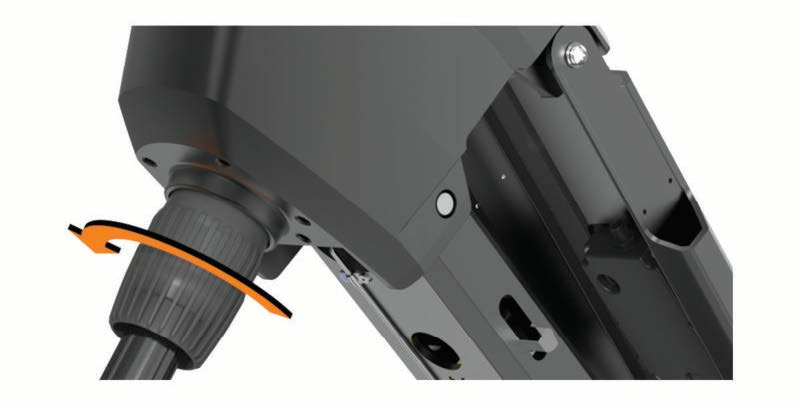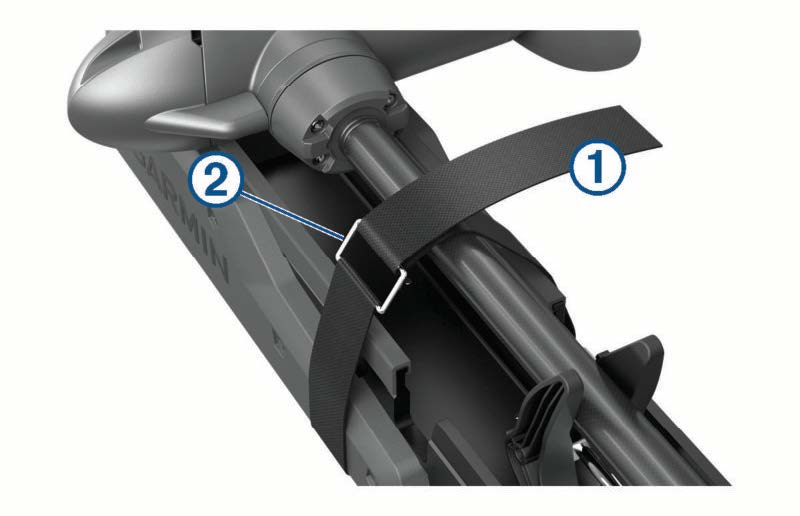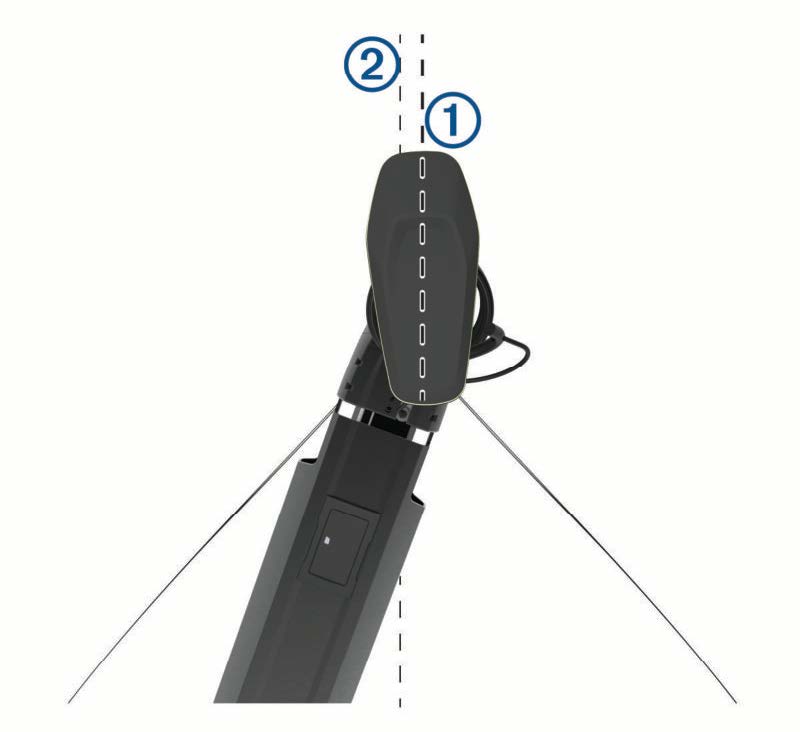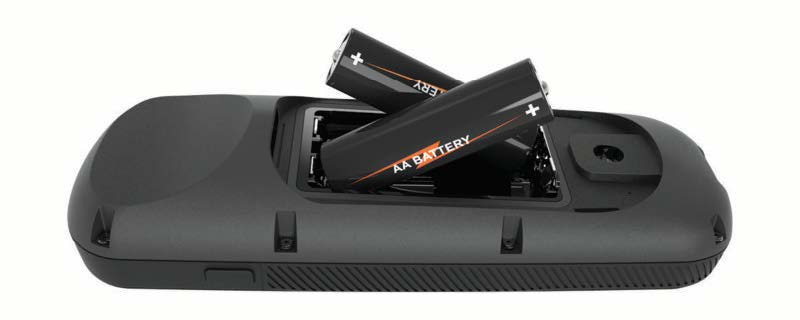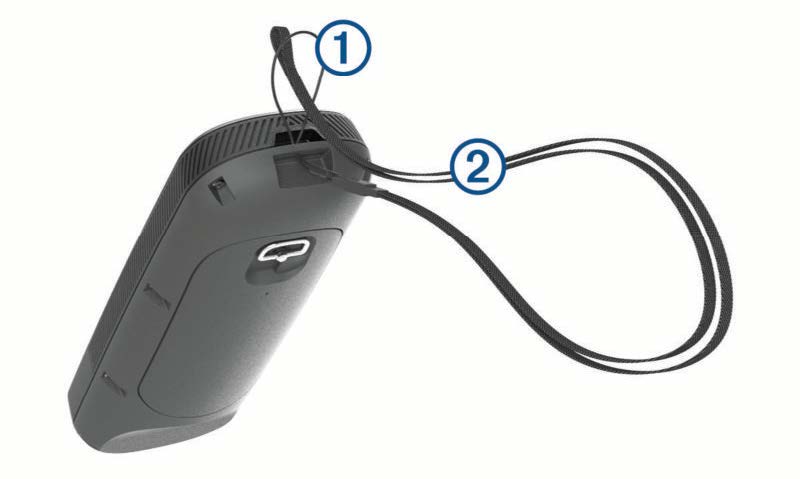GARMIN Force Trolling Motor
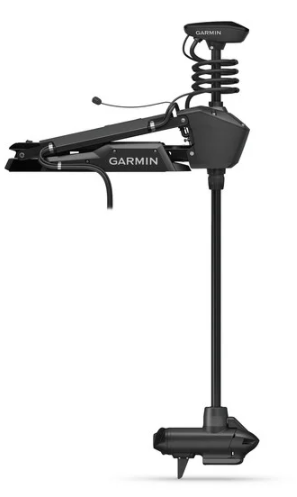
Getting Started
WARNING
- Do not run the motor when the propeller is out of the water. Contact with the rotating propeller may result in severe injury.
- Do not use the motor in areas where you or other people in the water may come into contact with the rotating propeller.
- Learn to operate the autopilot features on calm and hazard-free open water.
- Use caution when operating the trolling motor near hazards in the water, such as trees, shallow rocks, docks, pilings, and other boats.
- Always disconnect the motor from the battery before cleaning or servicing the propeller to avoid injury.
CAUTIONAlways keep the remote control on your person when using the trolling motor. If the operation of the trolling motor needs to be changed or stopped at any time, you can press on the remote control, press on the foot pedal, or press on the mount to stop the propeller.
- When using the autopilot features, be prepared for sudden stops, acceleration, and turns.
- When stowing or deploying the motor, be aware of the risk of entrapment or pinching from moving parts, which can result in injury.
- When stowing or deploying the motor, be aware of slick surfaces around the motor. Slipping when stowing or deploying the motor may result in injury.
NOTICEYou are required to secure the safety strap when stowing the trolling motor. Failure to secure the trolling motor in the stowed position using the safety strap may result in unexpected deployment, damaging the boat and trolling motor.
Deploying the Motor from the Stowed Position
- Disengage the safety strap.
- Pull the pull-cable back until it stops to release the latch, and continue to hold it tight.
- Lift the motor up and forward using the pull-cable, then lower it slowly into the deployed position.
- If necessary, push down on the mount arm to lock the motor in the deployed position.
Adjusting the Depth of the Trolling Motor
- Move the motor so that it stops halfway between the stowed and deployed positions.
- Loosen the collar at the base of the steering system housing.

- NOTE: You should be prepared for the motor to slide down when you loosen the collar.
- Tighten the collar at the base of the steering system housing.
- Select an action:
- If you are deploying the trolling motor, move the motor to the fully deployed position to check the depth.
- If you are stowing the trolling motor, move the motor to the stowed position to check the depth (Stowing the Motor from the Deployed Position, page 1).
- Repeat this procedure if necessary to set the correct depth for the deployed or stowed position.
Stowing the Motor from the Deployed Position
NOTICEYou must allow the drive motor to stop rotating completely to one side before moving it to the stowed position. If the motor is still rotating to one side when you move it to the stowed position, it may damage the steering system.
- Pull the pull-cable up until it stops to release the latch, and continue to hold it tight.
- Lift the pull-cable up and backward to lift and lower the motor slowly into the stowed position.
- If necessary, push down on the steering system housing to lock it in the stowed position.
- Secure the safety strap
NOTICEYou must adjust the depth of the trolling motor so it rests solidly on the rails of mount base in the stowed position (Adjusting the Depth of the Trolling Motor, page 1). If the depth is adjusted too shallow, it may press on the gas spring. If the depth is adjusted too deep, it may hang off the end of the mount base. Stowing the motor with the depth adjusted either too deep or too shallow will damage the motor.

Securing the Safety Strap
NOTICEYou are required to secure the safety strap when stowing the trolling motor. Failure to secure the trolling motor in the stowed position using the safety strap may result in unexpected deployment, damaging the boat and trolling motor.
The safety strap holds the motor securely to the base in the stowed position and prevents unintended deployment.
- With the motor in the stowed position, lift the long end of the strap over the top of the motor.

- Feed the end of the strap through the buckle on the other end of the strap.
- Pull the strap through the buckle until it holds the motor securely to the mount.
- Pull the strap away from the buckle, and push down to fasten
Trolling Motor Display Panel
The display panel on the trolling motor mount shows important information at a glance.NOTE: The backlight on the display panel reacts to the ambient light, and dims automatically at night.
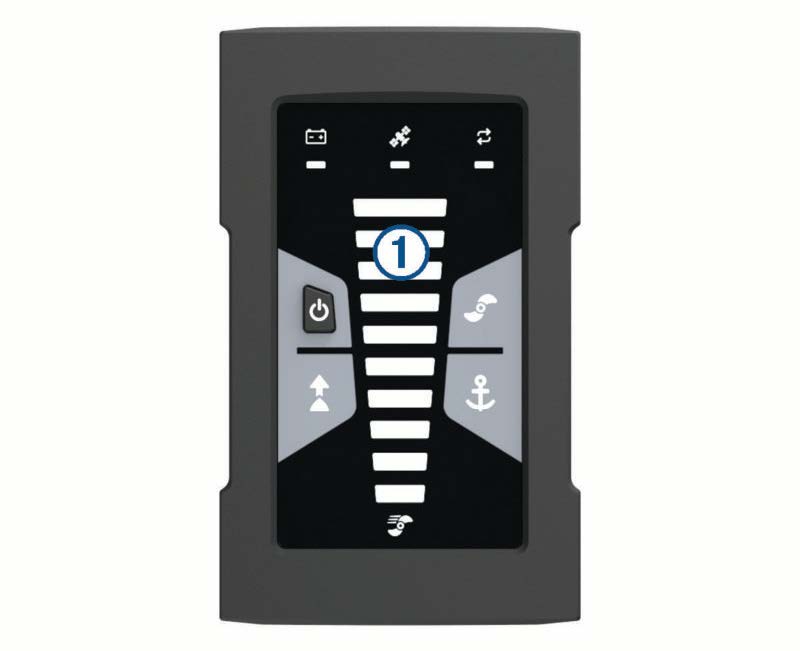
| Speed | Shows the motor speed level (Adjusting the Speed of the Motor, page 5). |
|
Trolling motor battery status |
Green: the motor battery voltage is good. Yellow: the motor battery voltage is low.
Red: the motor battery voltage is critically low. |
|
GPS signal status |
Green: the motor has a good GPS signal. Yellow: the motor has a poor GPS signal. Red: the motor does not have a GPS signal. |
|
Motor status |
Green: the motor is operating normally.
Red (solid): the motor software is starting up. Red (blinking): there is a system error. Blue: the motor is in pairing mode. Yellow: the motor is in recovery mode (for software updates and recovery procedures). |
| Power | Hold to turn the motor off.
NOTE: By default, the trolling motor turns on automatically when it receives power. It is not necessary to push this button to turn it on. This can be changed in the settings (Trolling Motor Settings, page 8). The trolling motor turns off automatically when it is in the stowed position for two hours. When the propeller is turning, press to stop the propeller. Press three times to enter pairing mode. |
| Propeller status | Illuminates when the propeller is on (Turning the Propeller On and Off, page 5). |
| Heading hold status | Illuminates when heading hold is on (Maintaining Your Heading, page 6). |
| Anchor lock status | Illuminates when anchor lock is on (Holding Your Position, page 6). |
Status Indicator
| Green | Normal operation |
| Red | Solid: system booting Blinking: system error |
| Blue | Pairing mode |
| Yellow | Recovery mode (for software updates and recovery procedures) |
Calibrating the Trolling Motor
You must calibrate the compass in the trolling motor before you can use the autopilot features. For the best results, you should calibrate the motor on a day with little or no wind on calm water. You can repeat the calibration process if the autopilot features are not performing as expected.
- Drive the boat to an open area of calm water and stop moving.The boat must be stationary to begin the calibration process.
- Make sure the trolling motor is deployed (Deploying the Motor from the Stowed Position, page 1).
- On the remote control, select > Settings > Trolling Motor Calibrate > Compass.
- Using the foot pedal or outboard motor to steer, follow the onscreen instructions.
Setting the Bow Offset
Based on the installation angle, the trolling motor may not align with the center line of your boat. For the best results, you should set the bow offset.
- Using the remote control, adjust the angle of the trolling motor so it aligns with the center line of your boat , pointing straight forward.

- On the remote control, select > Settings > Trolling Motor > Calibrate > Bow Offset.
- Repeat this procedure if necessary.
Connecting to a Chartplotter
Your compatible Garmin® chartplotter must have the latest software version installed before you can connect the trolling motor.
You can connect the trolling motor wirelessly to a compatible Garmin chartplotter on your boat. After you connect to a compatible chartplotter, you can control the trolling motor from the chartplotter in addition to the remote control and foot pedal.
- Turn on the chartplotter and the trolling motor.
- Make sure that the chartplotter is hosting a wireless network.NOTE: If you have multiple chartplotters installed, only one is the wireless network host. Consult your chartplotter’s owner’s manual for more information.
- On the chartplotter, select Settings > Communications > Wireless Devices > Garmin Trolling Motor > Start.
- On the trolling motor display panel, press three times to enter pairing mode.on the trolling motor display panel illuminates blue as it searches for a connection to the chartplotter, and changes to green when the connection is successful.A confirmation message appears on the chartplotter when the connection is successful.
- After the chartplotter and trolling motor connect successfully, enable the trolling motor bar on the chartplotter to control the motor.See the latest version of your chartplotter’s owner’s manual for complete operation instructions.
Remote Control
Installing Batteries
The remote control operates using two AA batteries (not included). Use lithium batteries for best results.
- Turn the D-ring counter-clockwise, and pull up to remove the cover.
- Insert two AA batteries, observing polarity.

- Replace the battery cover, and turn the D-ring clockwise.
Attaching a Lanyard
- Starting from the back of the remote control, insert the loop of the lanyard through the slot.

- Thread the other end of the lanyard through the loop, and pull it tight.
- If necessary, place the lanyard around your neck or wrist to tether it during use.
Remote Control Keys

| Key | Description |
| Hold to turn the remote control on and off. | |
|
|
Press to turn on and set the cruise control at the current speed over ground (SOG) (Maintaining Your Speed, page 5).
Press to disable the cruise control and return to manual speed control. |
|
|
If the propeller is on, press to set it to full speed (Toggling Full Speed, page 5).
If the propeller is off, press to enable the propeller and set it to full speed. Press again to return to the previous speed and propeller state. |
|
|
Press for manual control (Steering the Trolling Motor Manually, page 6).
Hold to steer using gestures (Using Gesture Controls to Steer, page 6). |
|
|
Press to turn the propeller on and off (Turning the Propeller On and Off, page 5). |
|
|
Press to navigate the menu (Navigating the Menu, page 4).
When in the menu, press to select a menu item, and press to go back. When in anchor lock, press to jog the anchor lock position forward, backward, left, or right in 1.5 m (5 ft.) increments. When in heading hold or manual control, press and for single-degree step turns, or hold for steering in five-degree increments. Press and for incremental speed changes, or hold for continuous speed changes. |
|
|
Press to turn on heading hold (set and maintain the current heading) (Maintaining Your Heading, page 6).
Press to turn off heading hold, stop the propeller, and resume manual control. Hold to set the heading hold by pointing the remote (Using Gesture Controls to Adjust the Heading Hold, page 7). |
|
|
Press to turn on anchor lock. Anchor lock uses the trolling motor to hold your position (Holding Your Position,
page 6). When in anchor lock, press to turn off anchor lock and return to the previous steering mode. Hold to jog the anchor lock position by pointing the remote (Using Gesture Controls to Adjust Your Held Position, page 7). |
|
|
Press to open the menu. Press to exit the menu. |
| Press to mark a waypoint. | |
| 1 through
4 |
Press to open the shortcut for the Garmin chartplotter assigned to the key. 1 |
Remote Control Screen

|
|
Shows the operational status of the trolling motor.
For example, when in manual control, Manual is shown, and when the heading hold is on, Heading Hold is shown, along with the heading-hold set point in degrees. |
|
|
Shows the trolling motor battery status. Green: the motor battery voltage is good. Yellow: the motor battery voltage is low.
Red: the motor battery voltage is critically low. TIP: You can change the appearance of the trolling motor battery status so that it shows a numeric value instead of an icon (Trolling Motor Settings, page 8). You can view the remote control battery level by pressing . |
|
|
Shows the status of the propeller.
When the propeller icon is shown, the propeller is on. When the propeller icon is not shown, the propeller is off. |
| Shows the GPS signal strength of the trolling motor. | |
| PROP | Shows the speed level of the propeller (Adjusting the Speed of the Motor, page 5).
NOTE: When using the cruise control feature, this field is replaced with . |
| SOG | Shows the measured speed over ground (SOG) in the specified units. |
You can use the menu and arrow keys to navigate the menu on the remote control.
- To open the menu, press .
- To move between different menu items, press and .
- To select a menu item, press .
- To move back to a previous menu item, press .
- To exit the menu, press , or press repeatedly until you reach the main screen.
Calibrating the Remote Control
NOTICECalibrate the electronic compass outdoors. To improve heading accuracy, do not stand near objects that influence magnetic fields, such as vehicles, buildings, and overhead power lines.
You must calibrate the compass in the remote control before you can control the motor using gestures. If the gesture controls are not working properly after calibration, you can repeat this process as often as needed.
- Select > Settings > Remote Control > Calibrate.
- Select Start, and follow the on-screen instructions.
Pairing the Remote Control
The remote control is paired with the trolling motor at the factory, but you may need to pair them again if the connection is broken.
- Turn on the trolling motor.
- On the trolling motor display panel, press three times to enter pairing mode.on the trolling motor display panel illuminates blue as it searches for a connection.
- Bring the remote control within 1 m (3 ft.) of the display panel on the trolling motor.
- Turn on the remote control.
- On the remote control, select > Settings > Remote> Control > Pair > Start.on the trolling motor display panel illuminates green when the connection is successful.
Foot Pedal
You can use the foot pedal to operate the trolling motor.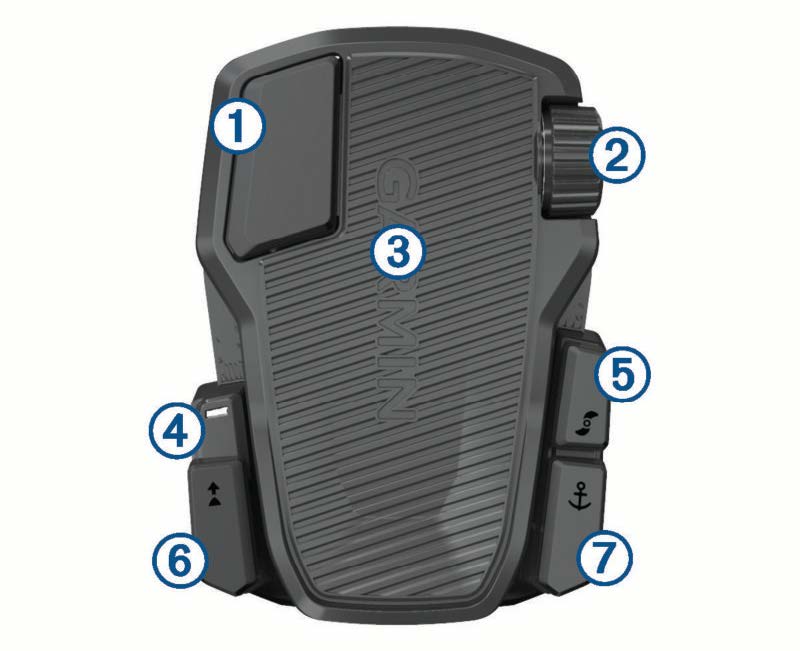
|
|
Momentary propeller control | Hold to turn on the propeller at the set speed. Release to turn off the propeller. |
|
|
Speed wheel | Rotate the wheel away from you to increase the propeller speed or cruise control speed.
Rotate the wheel toward you to decrease the propeller speed or cruise control speed. NOTE: The speed wheel is inactive when anchor lock is on. |
|
|
Steering pedal | Push the pedal with your toes to turn the motor clockwise.
Push the pedal with your heel to turn the motor counter-clockwise. NOTE: When anchor lock or heading hold is on, or you are following a route, press the pedal to resume manual control at the previous propeller speed. |
|
|
Status LED | Shows the status of the foot pedal (Status Indicator, page 5). |
| Continuous propeller control | Press to turn the propeller on and off (Turning the Propeller On and Off, page 5). | |
|
|
Heading hold | Press to set and maintain the current heading (Maintaining Your Heading, page 6).
Press to turn off heading hold, stop the propeller, and resume manual control. TIP: You can disable this function if you prefer (Disabling the Heading Hold Function on the Foot Pedal, page 5). |
|
|
Anchor lock | Press to turn on anchor lock. Anchor lock uses the trolling motor to hold your position (Holding Your Position, page 6).
Press to turn off anchor lock and return to the previous steering mode. |
Installing Batteries
The foot pedal can operate using two AA alkaline, NiMH, or lithium batteries (not included). Use lithium batteries for best results.
- Lift up the front of the foot pedal as far as possible.
- Pinch the sides of the battery cover , and pull up to remove it.

- Insert two AA batteries, observing polarity.
- Place the battery cover over the batteries, and push down until both sides snap into place.
Pairing the Foot Pedal
The foot pedal is paired with the trolling motor at the factory, but you may need to pair them again if the connection is broken.
- Turn on the trolling motor.
- On the trolling motor display panel, press three times to enter pairing mode.on the trolling motor display panel illuminates blue as it searches for a connection.
- Bring the foot pedal within 1 m (3 ft.) of the display panel on the trolling motor.
- Connect the foot pedal to power using the power cable, or insert batteries to turn it on.
- Within 30 seconds of turning on the foot pedal, hold until the status LED on the foot pedal illuminates blue.
- Release: The status LED on the foot pedal illuminates blue as it searches for a connection, then turns off when it pairs successfully with the trolling motor.on the trolling motor display panel changes to green when the connection is successful.
Status Indicator
The LED on the foot pedal indicates the foot pedal status.
| Illuminates green | The foot pedal is powering on. |
| Illuminates blue | The foot pedal is pairing. The LED turns off when it connects to the trolling motor or the pairing process times out without connecting. |
| Flashes green when pushing a button | The foot pedal is connected to the trolling motor and sending a command for the button being pushed. |
| Flashes red when pushing a button | The foot pedal is not connected to the trolling motor. |
| Off | The LED turns off when the pedal is connected to the trolling motor and not sending commands.
This prolongs battery life. |
Disabling the Heading Hold Function on the Foot Pedal
You can disable the heading hold function on the foot pedal to avoid accidentally engaging it.
- Make sure that the foot pedal has power.
- On the foot pedal, quickly press 6 times.The status LED turns red for 1 second to indicate that the heading hold function is disabled on the foot pedal.
TIP: To enable heading hold again, quickly press 6 times. The status LED turns green for 1 second to indicate that the heading hold function is enabled on the foot pedal.
Operation
You can use the remote control, the foot pedal, a compatible Garmin chartplotter, or a combination of these devices to operate the trolling motor.In general, most of the instructions provided for the remote control also apply to a connected chartplotter. For specific chartplotter instructions, see the latest owner’s manual for your chartplotter.NOTE: Some features available when using the remote control and chartplotter are not available when using the foot pedal only.
Turning the Propeller On and Off
WARNINGDo not use the motor in areas where you or other people in the water may come into contact with the rotating propeller.
- If necessary, deploy the trolling motor (Deploying the Motor from the Stowed Position, page 1).NOTE: The propeller cannot turn on when the trolling motor is in the stowed position.
- On the remote control or foot pedal, press to turn on the propeller.
- Press to turn off the propeller.
Adjusting the Speed of the MotorYou can adjust the speed of the trolling motor using the remote control or the foot pedal.
- If necessary, press on the remote control, or steer with the foot pedal, to enter manual mode.
- Select an option:
- On the remote control, press and to increase and decrease the speed of the motor.
- On the foot pedal, rotate the speed wheel away from you and toward you to increase and decrease the speed of the motor.The PROP field on the remote control and the bars on the display panel indicate the propeller speed (Trolling Motor Display Panel, page 2).
- If necessary, turn on the propeller (Turning the Propeller On and Off, page 5).The propeller speed you selected is retained if the propeller is turned off or if you start another function of the motor such as cruise control or anchor lock.
Toggling Full Speed
- On the remote control, The trolling motor propeller speed quickly increases to full speed.
- Press button to return to the previous propeller speed.TIP: When at full speed, you can press on the remote control to slowly decrease the propeller speed.
Maintaining Your SpeedBefore you can use the cruise control feature, you must calibrate the trolling motor (Calibrating the Trolling Motor, page 2).The cruise control feature is an autopilot function that sets and maintains a specific speed over ground, adjusting for changes in current and wind automatically.NOTE: You can enable the cruise control feature from the remote control only, but can control the speed and direction from both the remote control and foot pedal.
- On the remote control, press buttonCruise control is enabled at the present speed.
Settings
Trolling Motor SettingsOn the remote control, select > Settings > Trolling Motor. Wi-Fi: Sets the wireless network preferences for the trolling motor (Wireless Network Settings, page 9).Calibrate: Calibrates the trolling motor compass (Calibrating the Trolling Motor, page 2) and sets the trolling motor bow offset (Setting the Bow Offset, page 2).
Units: Sets the units of measure.Battery: Changes the appearance of the trolling motor battery indicator from an icon to a numeric value.Prop Stow Side: Sets which side of the trolling motor the propellor rotates to when stowing the trolling motor. This is helpful when you store other items near the stowed propellor.Auto Power On: Turns on the trolling motor when you apply power to the system.Heading Hold: Sets the behavior of the heading hold feature (Changing the Heading Hold Behavior, page 6).Nav. Arrival: Sets the behavior of the trolling motor when you reach the end of a route. With the Anchor Lock setting, the trolling motor holds the position using the anchor lock feature when the boat reaches the end of the route. With the Manual setting, the propeller turns off when the boat reaches the end of the route.
CAUTION: When using Manual for the Nav. Arrival setting, you must be ready to take control of the boat.
Anchor Gain: Sets the response of the trolling motor when in anchor lock mode. If you need the trolling motor to be more responsive and move quicker, increase the value. If the motor is moving too much, decrease the value.Navigation Gain: Sets the response of the trolling motor when navigating. If you need the trolling motor to be more responsive and move quicker, increase the value. If the motor is moving too much, decrease the value.Clear User Data: Deletes all saved waypoints, routes, tracks, and you active track.NOTE: If you are connected to a chartplotter, selecting this clears user data from both the trolling motor and the connected chartplotter.Restore Defaults: Resets the trolling motor settings to the factory default values.
Wireless Network Settings
On the remote control, select > Settings > Trolling Motor > Wi-Fi.NOTE: The active Wi‑Fi® mode is shown at the top of the screen.Mode: Sets the Wi‑Fi mode. You can turn off Wi‑Fi technology, join the network of a chartplotter, or create a wireless access point to use the ActiveCaptain® app (Getting Started with the ActiveCaptain App, page 9).Setup > Name: Sets the name of the wireless access point on the trolling motor (ActiveCaptain mode only).Setup > Password: Sets the password for the wireless access point on the trolling motor (ActiveCaptain mode only).
Maintenance Needs and Schedule
NOTICEAfter using the motor in salt water or brackish water, you must rinse off the entire motor with fresh water, and apply a water-based silicone spray using a soft cloth. You should avoid spraying jets of water at the cap on the top of the shaft when rinsing the motor.
To maintain your warranty, you must perform a series of routine maintenance tasks as you prepare your motor for the season. If you use or transport the motor in dry, dusty environments(traveling on gravel roads, for example) you should perform these tasks more often during the season.For detailed procedures and information on service and replacement parts, download the Force Trolling Motor Maintenance Manual from garmin.com/manuals/force_trolling_motor .
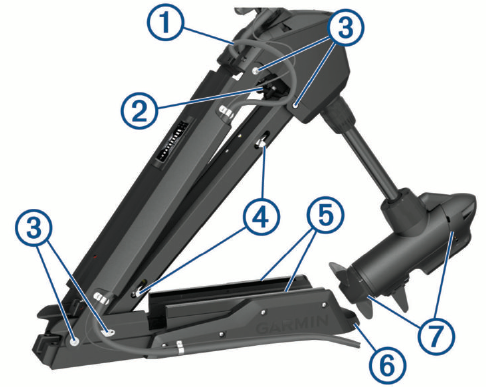
- Examine the power cable for wear, and patch, repair, or replace as necessary .
- Check and clean the power terminals and tighten the nuts, if necessary .
- Lubricate the hinges and bushings .
- Clean and lubricate the stow and deploy latch mechanism .
- Check the mount rails, and replace them if necessary .
- Check the mount bumper, and replace it if necessary .
- Clean or replace the anodes in the propeller drive motor .
Motor Information
Getting Started with the ActiveCaptain App You can connect a mobile device to the trolling motor using the ActiveCaptain app. The app provides a quick and easy way for you to interact with your trolling motor and update the device software.
- On the remote control, select > Settings > Trolling Motor > Wi-Fi > Mode > ActiveCaptain > Setup.
- Enter a name and password for this network.
- From the application store on your mobile device, install and open the ActiveCaptain app.
- Bring the mobile device near the trolling motor.
- From your mobile device settings, open the Wi‑Fi connections page and connect to the trolling motor, using the name and password you entered in the previous step.
Updating Software with the ActiveCaptain AppUpdating the trolling motor software also updates the software in all connected peripherals, such as the foot pedal and remote control.You can go to garmin.com/videos/trolling_motor_update/ and watch a video to assist with the software-update process.NOTICESoftware updates may require the app to download large files. Regular data limits or charges from your internet service provider apply. Contact your internet service provider for more information about data limits or charges.
The installation process can take several minutes.NOTE: To update the trolling motor, you must connect your mobile device directly to a dedicated Wi‑Fi network on the trolling motor using the ActiveCaptain app. You cannot update the trolling motor using a chartplotter.
- If necessary, set up the trolling motor for use with the ActiveCaptain app (Getting Started with the ActiveCaptain App, page 9).
- Connect the mobile device to the dedicated Wi‑Fi network on the trolling motor.Connecting to the Wi‑Fi network on the trolling motor provides the app with the information needed to download the appropriate update files.
- Open the ActiveCaptain app.
- Disconnect the mobile device from the dedicated Wi‑Fi network on the trolling motor.
- Connect the mobile device to the internet
- From the ActiveCaptain app, select My Marine Devices > Download.NOTE: The option to download an update is shown only if a software update is available for your device.The ActiveCaptain app downloads the update to the mobile device.
- Reconnect the mobile device to the dedicated Wi‑Fi network on the trolling motor.The update is transferred to the trolling motor. This could take up to 30 minutes to complete.
- After the transfer to the trolling motor is complete, turn off the trolling motor.
- Turn on the trolling motor.After approximately 30 seconds, the motor speed indicator lights on the trolling motor display panel blink to indicate that the software is updating.
- Make sure the remote control is turned on and connected.After the trolling motor software update is complete, if an update for the remote control is available, the speed indicator lights blink, and a countdown begins on the remote control. At the end of the countdown, the remote control displays while it completes the update process. This could take up to 5 minutes to complete.
- Make sure the foot pedal is turned on and connected. After the trolling motor software update is complete, if an update for the foot pedal is available, the indicator light on the foot pedal illuminates purple while it completes the update process. When the indicator light turns off, the update is complete.
Dimensions
Stowed Dimensions

| Item | 50 in. Model | 57 in. Model |
|
|
1.558 m (615/16 in.) min.
1.811 m (715/16 in.) max. |
1.712 m (673/8 in.) min. 2.066 m (815/16 in.) max. |
| 300 mm (1113/16 in.) | 340 mm (133/8 in.) |
Deployed Dimensions
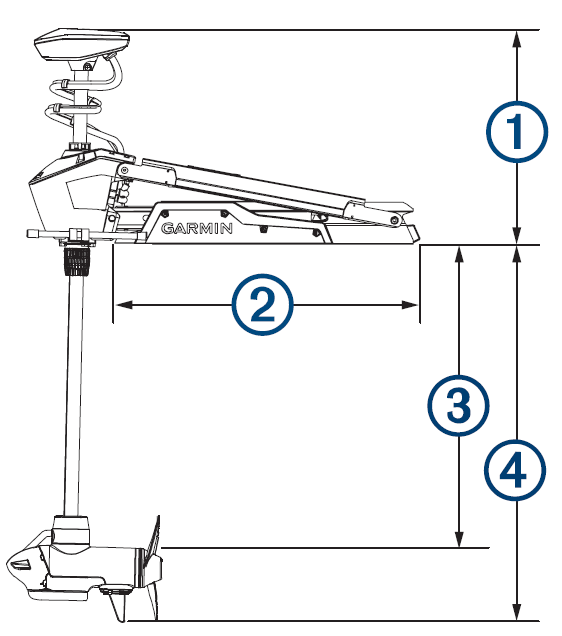
| Item | 50 in. Model | 57 in. Model |
|
|
461 mm (18 1/8 in.) min.
721 mm (28 3/8 in.) max. |
488 mm (19 3/16 in.) min.
817 mm (32 1/8 in.) max. |
| 708 mm (27 7/8 in.) | 799 mm (31 7/16 in.) | |
|
|
648 mm (25 1/2 in.) min.
889 mm (35 in.) max. |
737 mm (29 in.) min.
1.07 m (42 in.) max. |
|
|
839 mm (33 1/16 in.) min.
1.1 m (43 5/16 in.) max. |
920 mm (36 3/16 in.) min.
1.18 m (46 1/2 in.) max. |
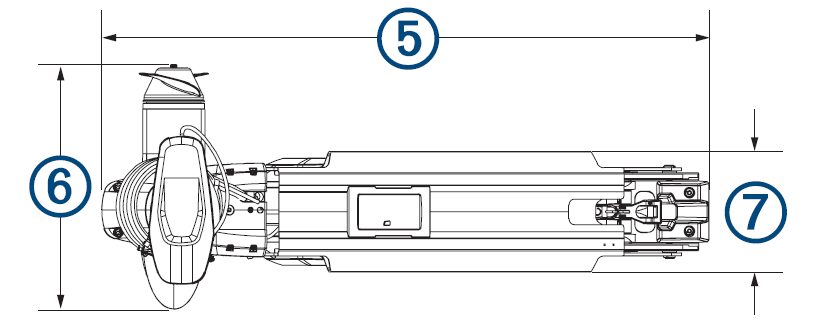
| Item | 50 in. Model | 57 in. Model |
| 931 mm (36 11/16 in.) | 1.022 m (40 1/4 in.) | |
| 402 mm (15 13/16 in.) | 402 mm (15 13/16 in.) | |
| 203 mm (8 in.) | 203 mm (8 in.) |
Registering Your Device
Help us better support you by completing our online registration today.
- Register using the ActiveCaptain app.
- Keep the original sales receipt, or a photocopy, in a safe place.
Contacting Garmin Support
- Go to support.garmin.com for help and information, such as product manuals, frequently asked questions, videos, and customer support.
- In the USA, call 913-397-8200 or 1-800-800-1020.
- In the UK, call 0808 238 0000.
- In Europe, call +44 (0) 870 850 1241.
Specifications
Trolling Motor
| Weight (motor, mount, and cables) | 50 in. model: 30 kg (66 lb.)
57 in. model: 31.75 kg (70 lb.) |
| Weight (stabilizer) | 0.54 kg (1.2 lb.) |
| Operating temperature | From -5° to 40°C (from 32° to 104°F) |
| Storage temperature | From -40° to 85°C (-40° to 185°F) |
| Material | Mount and motor housing: aluminum
Shaft cap, display panel, and side panels: plastic Motor shaft: fiberglass |
| Water rating | Shaft cap: IEC 60529 IPX51
Steering motor housing: IEC 60529 IPX72 Display panel housing: IEC 60529 IPX7 Propeller drive motor housing: IEC 60529 IPX83 |
| Compass safe distance | 91 cm (3 ft.) |
| Power cable length | 50 in. model: 1.2 m (4 ft.)
57 in. model: 1.1 m (3.5 ft.) |
| Input voltage | From 20 to 45 Vdc |
| Input amperage | 60 A continuous |
| Breaker (not included) | 42 VDC or greater, suitable for 60 A continuous
NOTE: You can protect the system by using a larger circuit breaker, not to exceed 90 A, if you are operating under high temperatures or if you are sharing the circuit with other devices. You should verify that your boat wiring meets marine wiring standards using a larger breaker before changing it. |
| Main power usage at 36 Vdc 60 A | Off: 72 mW
Full power: 2160 W |
| Radio frequency | 2.4 GHz @ 28 dBm nominal |
Motor Thrust and Current-Draw Information
You can refer to these tables to understand the relationship between the throttle level, output power, and current consumption of the motor. These values assume you are using an official Garmin power propeller, in relatively calm water, with the motor deployed deeply enough not to ventilate, and with tolerances of ±7 N-m (5 lbf) and ±5 A.
24.0 Vdc Power Source
| Throttle Level | Thrust | Current |
| 10% | 25 N-m (6 lbf) | 2 A |
| 20% | 45 N-m (10 lbf) | 3 A |
| 30% | 70 N-m (16 lbf) | 6 A |
| 40% | 101 N-m (23 lbf) | 9 A |
| 50% | 140 N-m (31 lbf) | 14 A |
| 60% | 184 N-m (41 lbf) | 21 A |
| 70% | 233 N-m (52 lbf) | 29 A |
| 80% | 287 N-m (65 lbf) | 40 A |
| 90% | 345 N-m (78 lbf) | 54 A |
| 100% | 355 N-m (80 lbf) | 57 A |
36.0 Vdc Power Source
| Throttle Level | Thrust | Current |
| 10% | 21 N-m (5 lbf) | 1 A |
| 20% | 41 N-m (9 lbf) | 2 A |
| 30% | 69 N-m (16 lbf) | 4 A |
| 40% | 103 N-m (23 lbf) | 6 A |
| 50% | 144 N-m (32 lbf) | 10 A |
| 60% | 191 N-m (43 lbf) | 15 A |
| 70% | 246 N-m (55 lbf) | 21 A |
| 80% | 307 N-m (69 lbf) | 29 A |
| 90% | 375N-m (84 lbf) | 39 A |
| 100% | 445 N-m (100 lbf) | 54 A |
- The part withstands projected water exposure from any direction (such as rain).
- The part withstands incidental immersion in water up to 1 m deep for up to 30 min.
- The part withstands continuous immersion in water up to 3 m deep.
Remote Control
| Dimensions (W×H×D) | 152 x 52 x 32 mm (6 x 2 x 11/4 in.) |
| Weight | 109 g (3.8 oz.) without batteries |
| Material | Glass-filled nylon |
| Display type | Sunlight-visible, transflective memory-in-pixel (MIP) |
| Display resolution | R240 x 240 pixels |
| Display size (diameter) | 30.2 mm (13/16 in.) |
| Operating temperature | From -15° to 55°C (5° to 131°F) |
| Storage temperature | From -40° to 85°C (-40° to 185°F) |
| Battery type | 2 AA (not included) |
| Battery life | 240 hr., typical use |
| Radio frequency | 2.4 GHz @ 10.0 dBm nominal |
| Water rating | IEC 60529 IPX7 |
| Compass-safe distance | 15 cm (6 in.) |
Foot Pedal
| Dimensions (L×W×H) | 303 × 221 × 110 mm (1115/16 × 811/16 ×
4 5/16 in. |
| Weight | 1.8 kg (4 lb) |
| Operating temperature | From -15° to 55°C (5° to 131°F) |
| Storage temperature | From -40° to 85°C (-40° to 185°F) |
| Water rating | IEC 60529 IPX7 |
| Material | Plastic |
| Input voltage | From 10 to 45 Vdc |
| Typical input current | < 1 mA @ 12 Vdc |
| Max input current | 10 mA @ 12 Vdc |
| Fuse (on the power cable) | 2 A mini-blade type |
| Power cable length | 2 m (6.6 ft.) |
| Battery type | Two AA batteries (Alkaline, NiMH, or lithium. Not included.) |
| Battery life | At least 1 year |
| Radio frequency | 2.4 GHz @ 0.8 dBm nominal |
| Compass-safe distance | 60 cm (2 ft.) |

References
[xyz-ips snippet=”download-snippet”]

